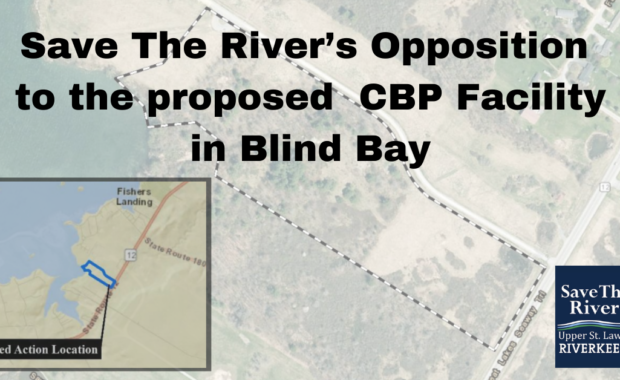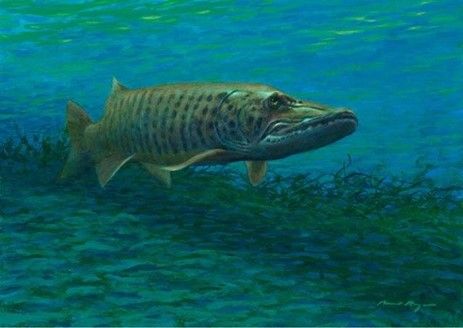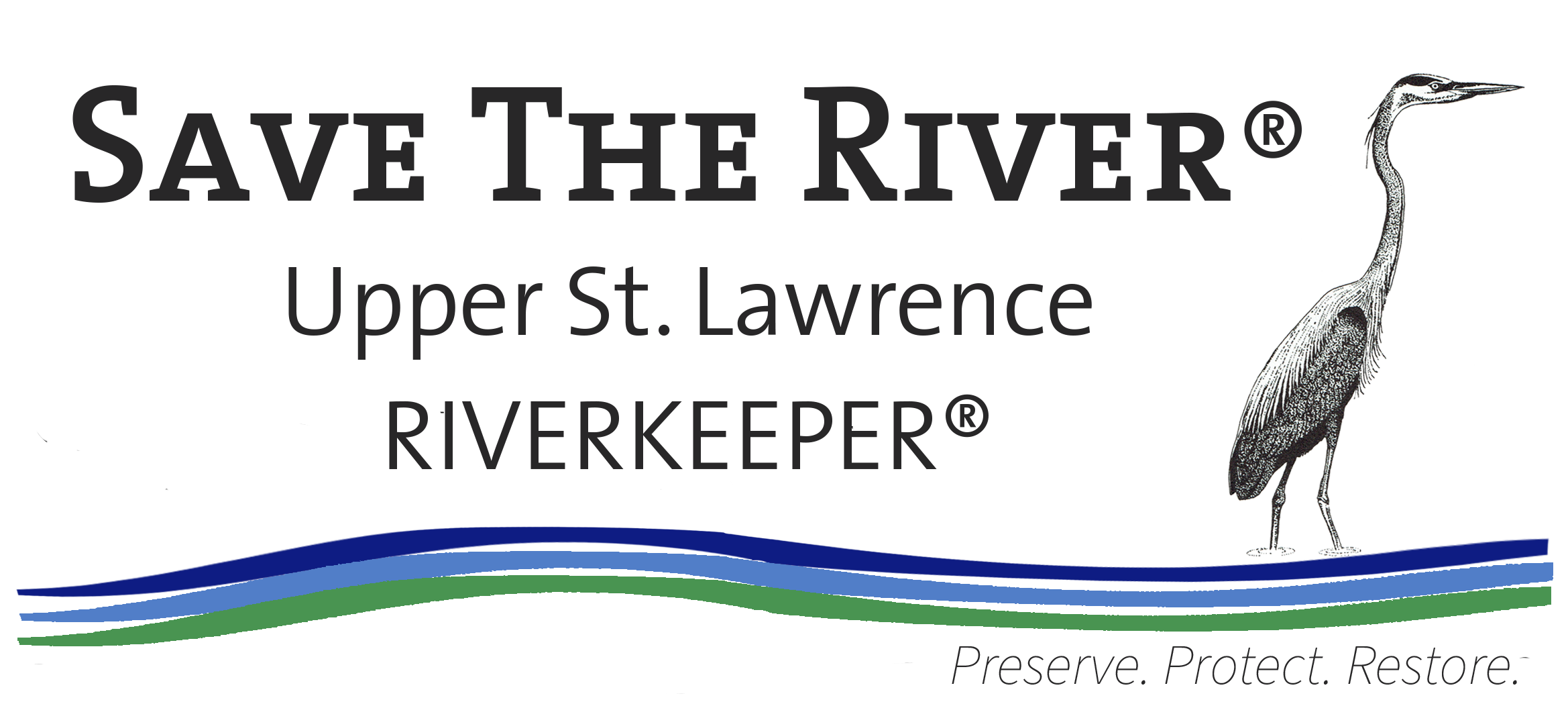Published by Thousand Islands Life Magazine Volume 17, Issue 3, March 2022
From Susie Smith
“Editor’s note: Over the winter of 2022, Save the River and dozens of other organizations emailed their opposition to the U.S. Customs and Border Protection’s (CBP) application to build a new US CBP Facility in the Blind Bay area at Fishers Landing, Town of Orleans, NY. We at TI Life believe that this is such an important subject that we asked STR to provide an article, for both US and Canadian readers, explaining the situation and what actions have been taken. The article includes a list of media stories already published, as well as letters from many organizations.
This is not a US problem, but rather a St. Lawrence River problem. Those on the Canadian side should be equally concerned – the simple fact is that the Muskies don’t stop at the white line. No fish do. If you are a fisherman, if your livelihood depends on tourism, or you want to raise your voice over the environmental issues, I highly recommend that you, too, write your elected officials (US or Canadian) and give your opinion about this project.
A fast Google search shows you that the Department of Homeland Security reports there is “no significant impact” for the project. What do you think?”
Save Blind Bay and the Muskie!
by John Peach and Lindsey Leve
One of the most significant remaining Thousand Islands muskie spawning beds is in danger of being ruined, by an ill conceived project proposed by US Customs and Border Protection (CBP) at Blind Bay in Fishers Landing, in the Town of Orleans. Save The River Upper St. Lawrence RiverkeeperⓇ, along with other riverfront community residents and organizations, was just recently made aware of the project. Save The River took immediate action to oppose this proposed project based on its concerns about the very real damage to the spawning beds of the River’s apex predator, the muskellunge.
“Blind Bay has open and protected wetland areas. It has served as a long-term aquatic habitat research site monitored by the Thousand Islands Biological Station (TIBS). Blind Bay has been one of the most prolific muskellunge spawning areas in the region and has been monitored since 1990. St. Lawrence River muskellunge have experienced a significant and recent decline due to losses associated with viral hemorrhagic septicemia (VHS). Maintenance of high-quality spawning and nursery habitat is critical to ensuring population recovery and sustainability. Other important fish species at the site are small and largemouth bass, northern pike, yellow perch, black crappie, bluegill, pumpkinseed, and bullhead; 53 fish species have been recorded at this location. In 2021, seining conducted by TIBS captured young-of-year muskellunge, northern pike, large and smallmouth bass, as well as NYS endangered pugnose shiner. Other NYS Species of Concern and Species of Conservation Need in the Blind Bay record include: American eel; blackchin, blacknose, and bridle shiner; Eastern musk turtle, and map turtle.
The eastern interior of Blind Bay has been largely unaffected by development and serves as a highly productive area for fish and wildlife. Critical habitats in shallow bays support fisheries, are considered biological hotspots, and support numerous ecological services including shoreline protection, flood reduction, biodiversity, and recreational opportunities including hunting, fishing, birdwatching, and nature education.
● Blind Bay is highly biodiverse. Blind Bay is a muskellunge spawning and nursery site being used in a recovery effort to restore populations impacted by habitat loss, invasive species, and disease. Habitat loss and alteration of these sites risk a negative impact on biological productivity.
● Diverse aquatic vegetation found in Blind Bay is known to serve as critical fish habitat. Loss and alteration of aquatic habitat leads to reduced fish production and can impact recruitment of sportfish to local populations ultimately impacting fisheries. Healthy fish populations and fisheries are important to the regional economy.
● Dockage areas proposed will require extensive dredging to be functional. This will damage critical habitat and disturb native sediments. Structures such as docks are known to attract invasive species; zebra and quagga mussels settle on hard surfaces, tubenose and round goby populations may increase. It is known that round goby harbor VHS.
● Riparian vegetation known to protect shorelines in storm events and serve as critical habitat for birds will be cleared. Sensitive birds that use this area will receive frequent disturbance. Bald Eagle, Green Heron, Great Blue Heron, Osprey, Belted Kingfisher, and waterfowl species are known to roost and feed in this area. There may be numerous other species impacted including secretive marsh birds.
● This proposed site is adjacent to a Thousand Islands Land Trust preserve that provides refuge to many important native species, which will be disturbed by the excessive lighting and activity caused by the operation of the new facility.
● Most of the 18.9-acre site will receive development and habitat conversion to hard impacted surfaces. This will increase surface runoff to the river and non-point source pollutants. Numerous harmful compounds are associated with the density and types of activities proposed. The scale of impact relative to the area is disproportionately high.”
Second Letter of Opposition
On Monday, March 7th Save The River sent a second letter to John Petrilla, Acting Environmental Branch Chief, at U.S. Customs and Border Protection, stating our opposition to the application to build the US Customs and Border Protection Facility in the Blind Bay area at Fisher’s Landing, Town of Orleans, NY.
In this letter, expressing its very real concerns to CBP, Save The River noted that, “The Town of Orleans has passed a formal resolution opposing the location of the CBP facility in Blind Bay”.
Quoting from the March 7, 2022 letter, STR requested that “. . . this project be withdrawn in its entirety.”
“The Draft Environmental Assessment (DEA) prepared for the project is deficient in many ways. As a result, the project should be scrapped entirely. In reviewing this DEA, the U.S. Customs and Border Protection (CBP) has failed to take a hard look at several extremely significant environmental impacts that can be expected, and thus a Finding of No Significant Impact (FONSI) is in error. If the CBP does decide to continue evaluating this project, it will need to conduct a full Environmental Impact Statement and open the project to complete public review. At the very beginning, there has been no outreach to the local and state agencies that know more about this site than the CBP and its contractors. An elementary look would have revealed that the proposed project violates local zoning ordinances, is proposed in a New York State designated wetlands area, would impact critical habitat for multiple aquatic and land-based species (some of which are endangered or threatened under federal and state law), and is within direct eyeline of Thousand Island Park, which is on the National Register of Historic Places. Failure to use the scoping process available, 43 CFR 46.235, resulted in these most obvious errors.
The DEA is flawed in numerous other respects, starting with PURPOSE AND NEED. The DEA fails to even acknowledge the recent $215 million dollar Customs and Border Protection project on Wellesley Island. CBP’s website states: “As the United States’ first unified border entity, CBP takes a comprehensive approach to border management and control, combining customs, immigration, border security, and agricultural protection into one coordinated and supportive activity.”
The Border Patrol, the enforcement arm of CBP, can easily be housed by that project.

For instance, parking is designed for over 200 employees, while only 75 now are used. The 12 detention facilities, very few of which are ever used, are more than enough for temporary detention. In case of arrest, the New York State Troopers usually take and house the detainees. Therefore, the DEA, and the project as a whole, should be DOA (dead on arrival).
ALTERNATIVES. The failure to even acknowledge the above mentioned CBP project, now nearly completed, contradicts CBP’s mission statement and constitutes a fundamental flaw in the alternatives analysis as the CBP has more than adequate new space.
Additionally, Mr. Yost’s comments for Thousand Island Park, submitted on March 3, on the proper NEPA alternatives analysis process are directly on point and specifically adopted herein. The alternatives analysis is the “heart” of NEPA, and therefore “an agency must on its own initiative study all alternatives that appear reasonable and appropriate for study at the time, and must also look into other significant alternatives that are called to its attention by other agencies, or by the public during the comment period afforded for that purpose.” Dubois v. Dept of Agriculture, 102 F.3d 1273, 1291 (1st Cir. 1996), quoting Seacoast Anti-Pollution League, v. Nuclear Reg. Comm’n, 598 F.2d 1221, 1231 (1st Cir. 1979) (emphasis from Dubois court) (internal citations omitted).
While it is not the public’s job to provide alternatives, the DEA furthermore fails to address the ability of the existing Wellesley Island facility to handle boat storage and River access and fails to mention access through the Coast Guard facility, its sister agency, next door. The boats that the Border Patrol might add, if shown to be necessary, could easily be housed on existing Wellesley Island facilities, or by renting extra dockage at the Thousand Islands Club, NYS Trooper docks at, for instance, Grasse Point, or sharing with other law enforcement in Alexandria Bay or Clayton.
Inland areas, or other places such as the Thousand Islands Bridge Authority, could house an additional facility without implicating the numerous environmental concerns of disturbing Blind Bay.
ENVIRONMENTAL CONSEQUENCES. While the environmental impacts of the project are numerous, one issue not addressed in the DEA and the subsequent FONSI is the impact of light pollution on the River community as a whole, and particularly on sensitive species. The recently completed CBP project on Wellesley Island has already contributed significant light pollution to the region. Night views in Eel Bay for example, have been substantially impaired. Failure to give more than cursory mention to light pollution from the proposed federal project, in addition to other recent projects in the area such as the new border station, constitutes segmentation under NEPA and a corollary failure to address cumulative impacts. Light pollution, among other things, also affects the nocturnal activities of bats, particularly endangered species such as the Indiana bat (Myotis sodalis) and the northern long-eared bat (Myotis septentrionalis) that are known to frequent the proposed project area.
Other environmental consequences, many of which are raised in the comments of Save the River, TILT, and Thousand Island Park, and expressly incorporated by reference herein, include impacts on NYS designated wetlands and muskellunge spawning and feeding grounds. With the Muskie being under extreme environmental pressures, preservation of their remaining habitat is imperative.
No mention is made of testing dredged sediments for legacy Great Lakes pollutants such as mercury, PCBs, dioxin, 2,4-D and its metabolites, DDT and its metabolites, as well as other heavy metals.

Painting titled: “Sovereign”, by Michael Ringer
No real analysis is done on affected birds pursuant to the Migratory Bird Treaty Act, nor is stormwater control discussed during construction and operation under the Clean Water Act, other than the cursory mention that generic BMPs would be used.
OTHER ISSUES. There is no mention of the need for additional federal space in the area, other than the oversimplified mention of the old Wellesley Island facility by the Coast Guard station. Blind Bay would be no more strategic a place than almost any other place already available.
For all of the reasons listed, including the scientific and public controversy surrounding this flawed proposal, the undersigned request that this project be withdrawn in its entirety.”
Following up on these two letters, Save the River has sent letters to politicians asking them to use their influence to block or stop this ill conceived project and have CBP find an alternative to destroying these very important remaining muskie spawning beds. You can add your voice to the over 1000 members and followers who have already emailed or written CBP expressing their opposition to this project here: https://www.savetheriver.org/uncategorized/send-a-letter-in-opposition-to-the-proposed-us-customs-and-bp-facility/
